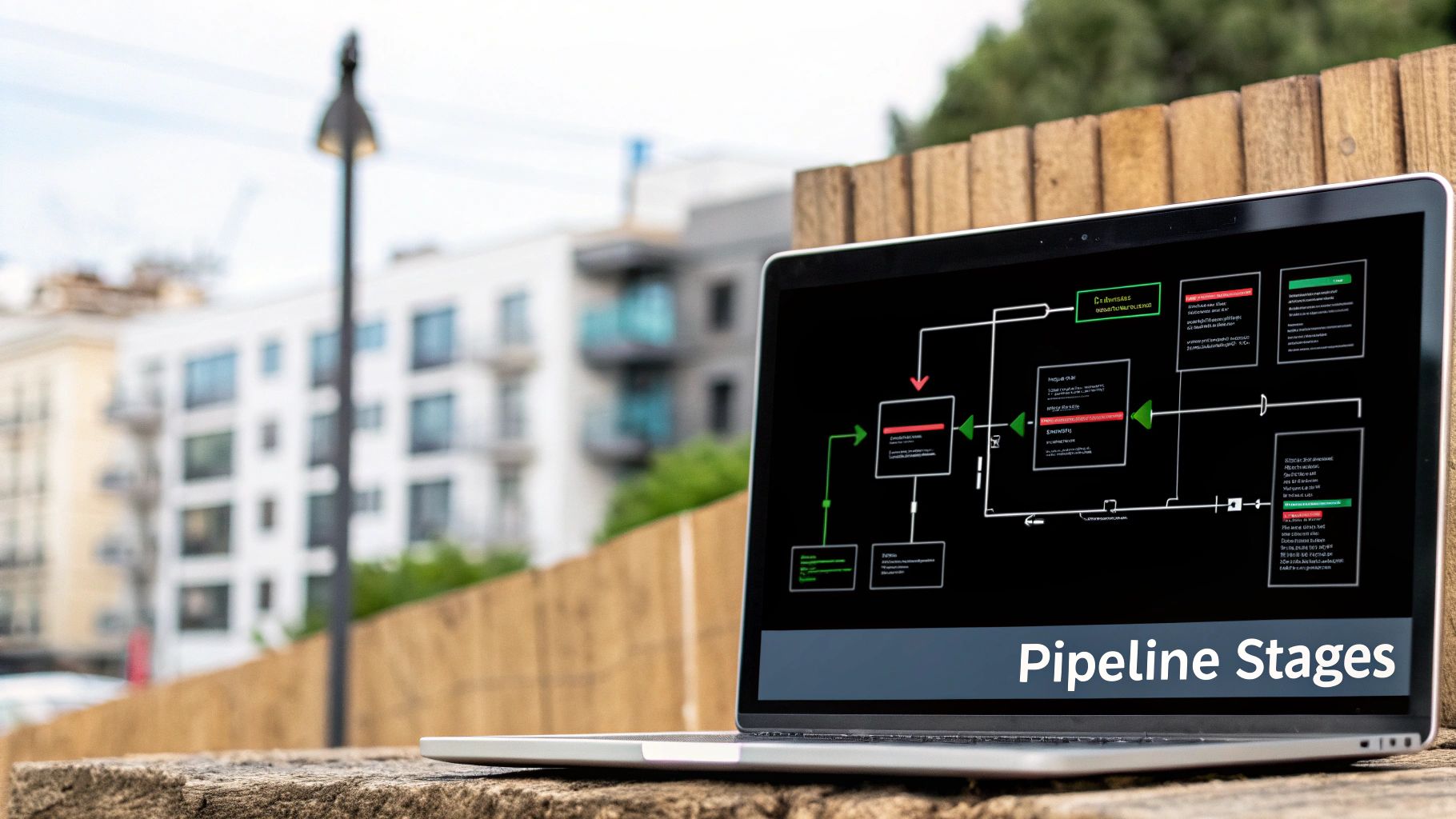CI/CD Pipeline Best Practices: The Complete Guide to Development Excellence
Building a Modern CI/CD Pipeline Foundation

A good CI/CD pipeline needs more than just automation - it requires a strong foundation for delivering software quickly, reliably, and securely. Building that foundation means carefully considering every aspect of the development cycle, from how code comes together to how it gets tested and deployed. Your pipeline needs to grow and adapt along with your team's needs.
Essential Elements of a Solid CI/CD Pipeline
The best CI/CD pipelines share a few key ingredients that work together to create smooth development workflows. It starts with version control - the backbone that lets teams track changes and work together effectively. Automated testing catches bugs early to maintain code quality. The build process itself needs automation to reduce human error and speed up development.
- Version Control: Tools like Git make it easy to branch, merge and review code
- Automated Testing: A complete test suite covering unit, integration and end-to-end testing
- Automated Builds: Consistent and fast compilation, packaging and build steps
Prioritizing Security in Your Pipeline
Security can't be an afterthought - it needs to be part of every pipeline stage from the start. This early security focus, known as DevSecOps, helps catch vulnerabilities before they become problems. For example, you can use static analysis tools to automatically check code for security issues during builds. Dynamic analysis tools can then test running applications for vulnerabilities. Learn more about CI/CD pipeline security.
The Power of Automation and Microservices
Automation drives effective CI/CD beyond just testing and builds. When you automate deployments too, the whole delivery process runs more smoothly. Adding a microservices architecture lets teams deploy and scale individual components independently for faster releases. Quick rollbacks help limit the impact of any production issues. Research shows real benefits - 48% of teams report fewer failed changes after adopting continuous deployment. Read the full statistics. Plus, 41% save money by reducing manual work.
Continuous Monitoring for Pipeline Health
Keeping a close eye on your CI/CD pipeline reveals important insights about performance and areas to improve. Track key metrics like build times, how often you deploy, and error rates to spot and fix bottlenecks early. Set up alerts when things fail or look unusual so teams can respond quickly to critical issues. Regular monitoring helps keep your pipeline running efficiently and aligned with what your business needs.
Mastering Pipeline Automation That Delivers Results

Moving from basic scripts to advanced automation requires a thoughtful strategy. Teams need to choose tools wisely, build robust testing frameworks, and create deployment processes that hold up in production. Let's explore how successful teams achieve this.
Selecting the Right Automation Tools
The foundation of any effective CI/CD pipeline starts with picking tools that fit your needs. There's no universal solution - your choice should align with your team's specific requirements. Key factors to consider:
- Integration Capabilities: How well does it work with your version control, build tools, and deployment platforms?
- Room for Growth: Can it handle increased load as your team expands?
- User Experience: Simple interfaces help team members contribute effectively
- Support Resources: Strong documentation and community help solve problems faster
For instance, while Jenkins offers deep customization options, GitLab CI/CD works especially well for teams already using GitLab's platform. Making this choice carefully sets you up for success.
Implementing Robust Testing Frameworks
Testing forms the core of successful CI/CD pipelines. A complete testing strategy includes unit tests, integration tests, and end-to-end tests to catch issues early. The goal is building quality checks into every step of development. For more insights on testing best practices, check out the CI/CD pipeline guide.
Parallel testing can dramatically speed up your pipeline. Running multiple tests at once gives developers faster feedback while maintaining code quality.
Creating Effective Deployment Processes
The final piece is automated deployment that you can trust. Two key approaches that help achieve this:
- Blue/Green Deployments: Run two identical environments and switch between them for zero-downtime updates
- Canary Releases: Test changes with a small user group first to spot issues before full rollout
Building Self-Healing Pipelines and Scaling for Growth
Advanced pipelines include automated recovery from common issues. For example, if a build fails due to temporary network problems, the system can retry automatically before alerting developers. This frees up team time for more important work.
Your pipeline should also grow with your needs. Many teams use a microservices approach where each component deploys independently. This gives teams more control and speeds up releases. The Pull Checklist tool helps maintain code quality during reviews, which becomes increasingly important as teams grow.
Performance Monitoring That Actually Improves Your Pipeline

A well-built CI/CD pipeline does more than just deliver code - it gives you clear insights into how your development process works. Smart performance monitoring helps teams spot issues early and make data-driven improvements, rather than just reacting to problems after they occur.
Identifying Key Performance Indicators (KPIs)
The first step is picking the right metrics to track. Good KPIs should directly show how well your pipeline meets business goals. Key metrics to monitor include deployment frequency, lead time for changes, and mean time to recovery (MTTR). You'll also want to track error rates and build times to find slowdowns and problems. These numbers give you concrete data to guide improvements.
Creating Actionable Feedback Loops
Getting data is just the start - you need a system that turns those numbers into real changes. Set up alerts for major issues, look for patterns in problems that keep coming up, and use what you learn to make your pipeline better. For example, if builds consistently take too long, you might need better build tools or parallel testing. Good feedback loops help you turn raw data into meaningful upgrades.
Optimizing Resource Usage and Maintaining Pipeline Health
Monitoring helps you get the most from your resources. By seeing exactly how your pipeline uses computing power and time during each stage, you can spot waste and fix inefficient processes. Focus on making your builds faster, running tests more efficiently, and deploying code in smarter ways. This creates a pipeline that's both cost-effective and reliable while keeping quality high.
Consistent monitoring and feedback are essential for any CI/CD pipeline. Regular analysis of your metrics reveals long-term trends and shows where you can improve. Looking at historical data helps teams spot recurring problems and track progress over time. Learn more about effective monitoring in this guide on CI/CD pipeline performance monitoring.
Building Effective Monitoring Dashboards
Clear, well-designed dashboards make it easy to understand pipeline performance at a glance. Your dashboard should show key metrics in a simple format that helps teams quickly assess pipeline health and make good decisions. Use interactive charts, customizable views, and automated reports to make monitoring more useful. Keep dashboards focused on the most important metrics - too much information can be overwhelming. For more development process resources, check out the Pull Checklist sitemap. Pull Checklist helps improve code quality through better code reviews.
When you combine smart monitoring tools with real feedback loops and clear dashboards, you create a pipeline that keeps getting better. This means catching fewer bugs late in development and steadily improving your performance metrics.
Building Security-First CI/CD Pipelines

While speed matters in CI/CD pipelines, security cannot take a back seat. Integrating security at every stage protects your applications and data from threats. This approach, known as DevSecOps, makes security an essential part of development rather than an afterthought.
Integrating Security Scanning into Your Pipeline
Adding automated security scanning to your pipeline helps catch issues early. Static Application Security Testing (SAST) checks your source code for problems without running it, while Dynamic Application Security Testing (DAST) finds vulnerabilities in running applications. By catching security flaws during development, you prevent them from reaching production.
Managing Secrets and Credentials Securely
Keeping sensitive data like API keys and database credentials safe is critical. Never store these secrets directly in code or config files - it's a major security risk. Use dedicated tools for managing secrets that provide secure storage, access controls, and encryption. This prevents unauthorized access to sensitive information.
Maintaining Compliance Requirements
Many organizations must follow specific security standards. Build compliance checks into your pipeline to ensure your code meets requirements like PCI DSS, HIPAA, or GDPR. Automated checks help avoid the legal and financial risks of non-compliance.
Automating Security Testing and Vulnerability Management
Regular security testing throughout the pipeline helps identify issues early. Use scanning tools to find known vulnerabilities in your code and dependencies. Have a clear process for addressing security problems when found. You might be interested in: How to master your development processes using Pull Checklist.
Fostering a Security-Aware Development Culture
Building secure pipelines requires a team that prioritizes security. Train developers on secure coding, make security reviews routine, and consider security at each development stage. When teams take ownership of security, applications become more robust. Making security a shared responsibility creates better protection than treating it as an add-on step.
Implementing Testing Strategies That Scale
Good test automation is essential for building a strong CI/CD pipeline. Not just automating tests, but creating a testing system that can handle growing demands while keeping release cycles fast. Let's look at how to build a testing approach that works at any scale.
Structuring Test Suites for Maximum Impact
A well-structured testing approach uses different types of tests in a pyramid pattern:
- Unit Tests: The base level testing individual code components. These fast, focused tests should cover most of your codebase. Unit tests verify that small pieces work correctly on their own.
- Integration Tests: The middle layer checking how components work together. These catch issues that unit tests miss, ensuring different parts integrate smoothly.
- End-to-End Tests: The top layer running full user workflows. While slower to run, these verify that critical user paths work from start to finish.
This pyramid approach balances speed and coverage - lots of quick unit tests supported by targeted integration and E2E tests.
Implementing Parallel Testing Effectively
Running tests one after another creates bottlenecks as projects grow. Parallel testing runs multiple tests at once, cutting total test time significantly. Most CI/CD tools can split tests across machines. For example, a 1-hour test suite could finish in just 5-10 minutes with good parallelization. This faster feedback helps teams catch and fix issues quickly.
Strategies for Test Data Management and Environments
Managing test data requires care to avoid security risks. Key approaches include:
- Data Subsetting: Use small, representative samples of production data
- Data Masking: Hide sensitive info while keeping data structure intact
- Synthetic Data: Create fake but realistic test data
Separate test environments are also important:
- Dedicated Environments: Match production setup closely for accurate testing
- Temporary Environments: Create and remove test environments as needed
Good data and environment management keeps testing reliable and secure. Pull Checklist helps teams run consistent code reviews even with complex testing needs.
Measuring Testing Effectiveness
Track these key testing metrics:
- Code Coverage: The percent of code tested, aiming for high but strategic coverage
- Test Run Time: Total time to run all tests - optimize slow tests
- Production Defect Rate: How many bugs reach users - shows testing quality
Regular measurement helps spot areas to improve your testing approach and build a more efficient CI/CD pipeline.
Scaling CI/CD Excellence Across Your Organization
As teams grow, running an effective CI/CD pipeline becomes more challenging. Success requires thoughtful decisions about tools, processes, and team collaboration. Here's how to scale your CI/CD practices effectively across a growing organization.
Managing Complex Pipeline Architectures
Simple pipelines that work for small teams often struggle at scale. Consider these key architectural approaches:
- Microservices Pipelines: Split applications into independent microservices so teams can deploy separately without dependencies on other groups. This increases speed and flexibility.
- Pipeline as Code: Store pipeline configurations in version control just like application code. Apply thorough testing and review processes to maintain quality.
- Modular Design: Create reusable pipeline building blocks. This makes maintenance simpler since you can update components without impacting the whole system.
Ensuring Consistency Across Distributed Teams
With remote and distributed teams, maintaining consistent practices becomes vital:
- Standard Templates: Provide templates defining core pipeline stages, testing requirements, and approval workflows that all teams follow.
- Central Documentation: Build a knowledge base covering architecture diagrams, troubleshooting guides, and best practices. Make it easily accessible to everyone.
- Common Tools: Use the same CI/CD platforms across teams to enable knowledge sharing and simplify onboarding.
Cultivating a Culture of Continuous Improvement
Scaling excellence requires ongoing refinement of your processes:
- Regular Reviews: Schedule pipeline retrospectives where teams discuss what's working well and areas needing improvement.
- Key Metrics: Monitor metrics like deployment frequency, change lead time, and recovery time. Use data to spot bottlenecks.
- Quick Feedback: Add automated feedback on test results, code quality, and security throughout the pipeline to catch issues early.
Addressing Technical Debt and Legacy Systems
Legacy code and technical debt need special handling during scaling:
- Step-by-Step Updates: Take an incremental approach to modernizing legacy systems rather than a complete rewrite. Start by adding basic CI/CD automation.
- Refactoring Tools: Use automated tools to help clean up and improve code quality systematically over time.
- Strategic Focus: Begin with the most important legacy systems to maximize impact while minimizing disruption.
Streamline your code reviews and enhance your CI/CD pipeline with Pull Checklist. Our GitHub Marketplace app provides automated, condition-based checklists to improve code quality and consistency. Learn more about how Pull Checklist can elevate your CI/CD pipeline.
